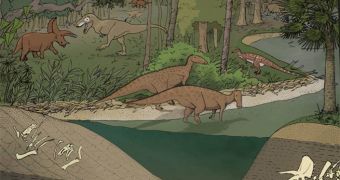In a new series of scientific investigations, experts have demonstrated that analysis of the places where dinosaurs died and were buried can reveal additional insight into how the animals lived.
Using the new approach, a team of researchers was already able to determine that the renowned predator Tyrannosaurus Rex lived anywhere there was meat, whereas duck-billed dinosaurs tended to come together alongside river banks.
Additionally, it was discovered that Triceratops tended to steer clear of rivers unless they absolutely had to. Paleontologists now believe that may have discovered why this happened.
Studies of the North American coastal lowlands have revealed a surprising concentration of dinosaurs, which means that the giant animals lived very close to each other at all times.
As such, they may have unknowingly divided the land they were occupying among themselves, so as to avoid slamming into each other all day long, LiveScience reports.
This conclusion belongs to Yale University vertebrate paleontologists Tyler Lyson and Nicholas Longrich, who were the leaders of the new study.
The team looked at no less than 343 dinosaur fossils, that are part of 43 museum collections around the world. A correlation was evidenced between the type of rock the fossils were found in and the species they belonged to.
“We can use the rock enclosing these fossils as clues to what they were up to. We're using what paleontologists usually throw away when excavating the fossils as clues to where they're spending most of their time,” Lyson explains.
For example, most of the 180 Triceratops remnants that the team analyzed were discovered in mudstone that had been laid down on floodplains.
On the other hand, some 80 duck-billed dinosaurs were discovered in sandstone more often than in any other type of rock.
“It makes sense these different herbivores are spatially separated – if you look at modern times, white-tailed deer hang out by rivers while mule deer are by the plains,” Lyson goes on to say.
But studies of T. Rex fossils identified no discernible pattern of distribution. “That makes sense – as the sole large carnivore in this time and place, it would go to wherever meat was,” the expert concludes.
Details of the work appear in the October 13 online issue of the esteemed scientific journal Proceedings of the Royal Society B.

 14 DAY TRIAL //
14 DAY TRIAL //